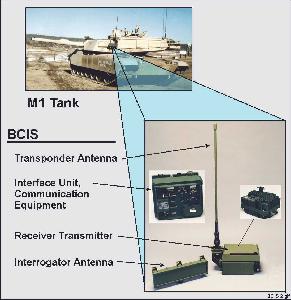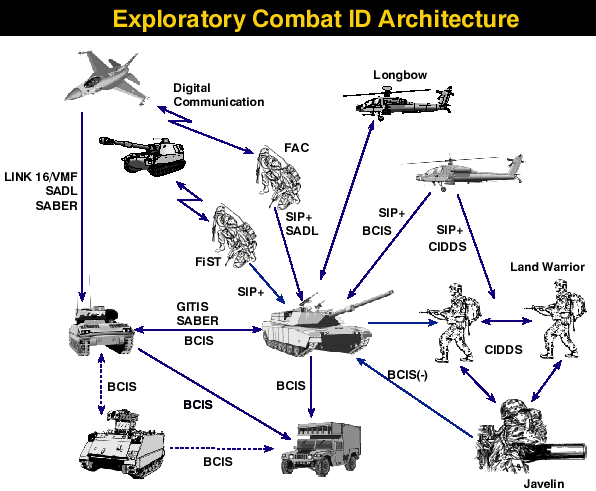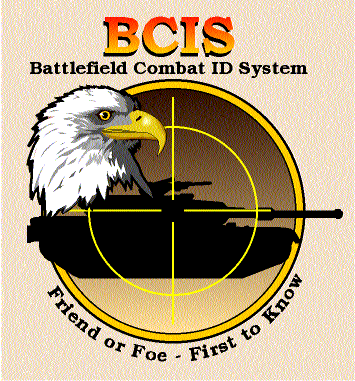




 The Battlefield Combat Identification System (BCIS) reduces the risk of fratricide by identifying BCIS-equipped targets under degraded environmental conditions. Fratricide is the employment of friendly weapons and munitions with the intent to kill the enemy or destroy his equipment or facilities, which results in unforeseen and unintentional deaths or injury to friendly personnel. In a 13 August 1991 news conference, Department of Defense officials announced that during the Persian Gulf War 35 Americans were killed and 72 wounded by "friendly fire". As these incidents of fratricide occurred in Operation Desert Storm, a number of "Quick Fix" solutions were provided to the troops.
As targeting and weapon systems continue to improve in lethality and range, the development of better fratricide avoidance systems must continue. Combat Identification is a critical requirement for the battlefield of the future. It is recognized that the highest payoff is achieved through positive hostile identification. If this cannot be achieved to the required degree of performance under all battlefield conditions, it will be necessary, at least, to ensure that friendly forces are not engaged. Additionally, the engagement of neutrals should be minimized. Therefore, a combination of non-cooperative systems, cooperative systems, and improved use of Situational Awareness (SA) would be employed simultaneously on the future battlefield in a variety of implementations depending on weapon system requirements and economic constraints. The successful Battlefield Combat Identification System (BCIS) development program, provided system hardware in 1995 that has met and/or exceeded the Army expectations for capability and performance.
The Battlefield Combat Identification System (BCIS) reduces the risk of fratricide by identifying BCIS-equipped targets under degraded environmental conditions. Fratricide is the employment of friendly weapons and munitions with the intent to kill the enemy or destroy his equipment or facilities, which results in unforeseen and unintentional deaths or injury to friendly personnel. In a 13 August 1991 news conference, Department of Defense officials announced that during the Persian Gulf War 35 Americans were killed and 72 wounded by "friendly fire". As these incidents of fratricide occurred in Operation Desert Storm, a number of "Quick Fix" solutions were provided to the troops.
As targeting and weapon systems continue to improve in lethality and range, the development of better fratricide avoidance systems must continue. Combat Identification is a critical requirement for the battlefield of the future. It is recognized that the highest payoff is achieved through positive hostile identification. If this cannot be achieved to the required degree of performance under all battlefield conditions, it will be necessary, at least, to ensure that friendly forces are not engaged. Additionally, the engagement of neutrals should be minimized. Therefore, a combination of non-cooperative systems, cooperative systems, and improved use of Situational Awareness (SA) would be employed simultaneously on the future battlefield in a variety of implementations depending on weapon system requirements and economic constraints. The successful Battlefield Combat Identification System (BCIS) development program, provided system hardware in 1995 that has met and/or exceeded the Army expectations for capability and performance.
BCIS is a secure, encrypted question and answer identification system which provides a high confidence, ground combat vehicle identification capability. The system operates in the millimeter wave (mmW) frequency region at 38Ghz. The "Shooter Platform" has an interrogator antenna boresighted to the gunners targeting system and integral with the platforms laser rangefinder sub system. Other major components of the BCIS system integrated on the platform are shown below. The receiver - transmitter unit and display module are mounted in the vehicle commander's area.
BCIS allows the gunner or commander to make a rapid shoot/don't shoot decision at the point of engagement. Shooter platforms, e.g., tanks and fighting vehicles are equipped with BCIS interrogator/transponder units that are used to interrogate suspect platforms, and respond to interrogations from other shooters. The interrogation process is automatically triggered by activation of the shooter's laser rangefinder, sending an encrypted query to the targeted platform. If the target is friendly, its transponder receives the query and responds with an encrypted answer (nonshooter platforms are equipped with BCIS transponder only units). When the interrogator receives an encrypted answer, it gives a "friend" response to the gunner/commander. If an invalid answer, or no answer is received, an "unknown" response is provided to the gunner/commander who then must continue using engagement tactics, techniques, and procedures. Responses are provided visually in the gunner's sight, and/or as an audible tone on the intercom system eliminating the need for a gunner to remove his eyes from the target. A Low Rate Initial Production (LRIP) award was scheduled for 3QFY99 with fielding to the 4th ID at Ft. Hood TX. scheduled to begin in FY01.
